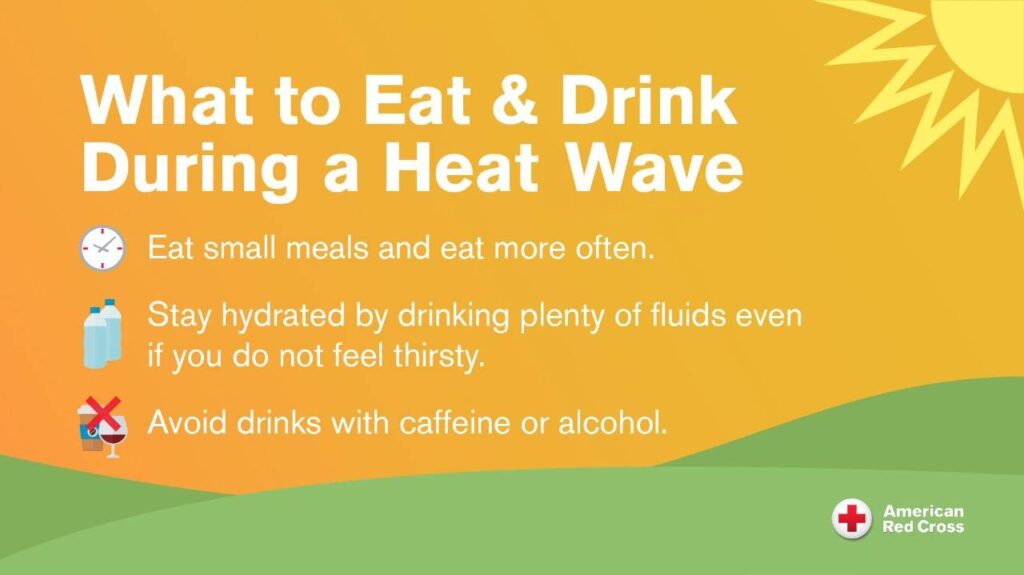- South Texas Students Meet Accordion Music Icons Los Tigres Del Norte In Edinburg Thanks To Khs America/Hohner Alianza Académica Initiative
- Fragile Planet Offers a Nighttime Wildlife Experience
- Falcons Soccer Off & Running
- Cameron County Receives Funds to Improve Two Parks
- Falcons Complete First Half of 32-6A
- School District to Help out Victims of California Wildfires
- Sand Castle Days Continued Despite Unexpected Weather
- Ready for District
- Discussion of Garbage Dumpster Rates, Agreements Between State & City on Highway Regulations, and More
- 31st Annual Shrimp Cook-Off is Right Around the Corner
Deadly Heat Still Impacting Millions – Follow Red Cross Safety Steps
- Updated: August 19, 2023

Friday, August 4,2023- While some parts of the country are cooling off, close to 70 million people in the South, West and Midwest will see dangerously high temperatures continue this week. The American Red Cross is standing by to support cooling centers and offers steps you can take to help stay safe when the temperatures soar.
To find a cooling center, contact your local Red Cross chapter or monitor local news outlets.
WHO’S AT RISK? Heat is the leading weather-related killer in the U.S. More than 700 people in this country die every year from heat-related illnesses, according to the Centers for Disease Control and Prevention (CDC). In some regions, hospitals are seeing a high level of patients with heat-related illnesses and several states are reporting deaths attributed to the extreme heat.
Some people are more at risk of developing a heat-related illness, including adults over 65, those with chronic medical conditions, people who work outside, infants and children, and athletes. Some may take medications that make the effects of extreme heat worse. People with heart disease, poor blood circulation, obesity and mental illness are also at risk for getting sick if the temperatures climb.
HEAT SAFETY TIPS The Red Cross offers steps you can take to help stay safe when the temperatures soar.
Hot cars can be deadly. Never leave children or pets in your vehicle. The inside temperature of the car can quickly reach 120 degrees.
Stay hydrated by drinking plenty of fluids. Avoid drinks with caffeine or alcohol.
Check on family, friends and neighbors who do not have air conditioning, who spend much of their time alone or who are more likely to be affected by the heat.
If you don’t have air conditioning, seek relief from the heat during the warmest part of the day in places like schools, libraries, theaters, malls, etc.
Avoid extreme temperature changes.
Wear loose-fitting, lightweight, light-colored clothing. Avoid dark colors because they absorb the sun’s rays.
Slow down, stay indoors and avoid strenuous exercise during the hottest part of the day.
Postpone outdoor games and activities.
Take frequent breaks and use a buddy system when working outdoors.
Check on animals frequently to ensure that they are not suffering from the heat. Make sure they have plenty of cool water and shade.
Excessive heat can lead to sunburn, heat cramps, heat exhaustion and heat stroke. If someone is experiencing heat cramps in the legs or abdomen, get them to a cooler place, have them rest, lightly stretch the affected muscle, and replenish their fluids with a half a glass (about 4 ounces) of cool water every 15 minutes.
If someone is exhibiting signs of heat exhaustion (cool, moist, pale or flushed skin, heavy sweating, headache, nausea, dizziness, weakness and exhaustion), move them to a cooler place, remove or loosen tight clothing and spray the person with water or apply cool, wet cloths or towels to the skin. Fan the person. If they are conscious, give small amounts of cool water to drink. Make sure the person drinks slowly. Watch for changes in condition. If the person refuses water, vomits or begins to lose consciousness, call 911.
HEAT STROKE LIFE-THREATENING Heat stroke usually occurs by ignoring the signals of heat exhaustion. Heat stroke develops when the body systems are overwhelmed by heat and begin to stop functioning. Signs include hot, red skin which may be dry or moist; changes in consciousness; vomiting and high body temperature. Call 911 immediately if someone shows signs of heat stroke. Move the person to a cooler place. Quickly cool the person’s body by immersing them up to their neck in cold water if possible.
Otherwise, douse or spray the person with cold water, or cover the person with cold, wet towels or bags of ice.
DOWNLOAD RED CROSS APPS Download the free Red Cross First Aid app so you’ll know what to do if emergency help is delayed and the free Emergency app for weather alerts, open Red Cross shelter locations and safety steps for different emergencies. Choose whether you want to view the content in English or Spanish with an easy-to-find language selector. Find these and all of the Red Cross apps in smartphone app stores by searching for the American Red Cross or going to redcross.org/apps.
CLIMATE CRISIS Some experts attribute the heatwave to the climate crisis, with extreme heat shattering temperature records all over the globe. Heatwaves in the U.S. are happening more often, lasting longer, and bringing more intense heat. As these conditions and other extreme weather disasters increase, more people need help from the Red Cross. Find out more about the American Red Cross and its work on the climate crisis here.
About the American Red Cross:
The American Red Cross shelters, feeds and provides comfort to victims of disasters; supplies about 40% of the nation’s blood; teaches skills that save lives; distributes international humanitarian aid; and supports veterans, military members and their families. The Red Cross is a nonprofit organization that depends on volunteers and the generosity of the American public to deliver its mission. For more information, please visit redcross.org or cruzrojaamericana.org, or visit us on Twitter at @RedCross.



